Analysis of Management and Organisation in Global Environment Report
VerifiedAdded on 2021/06/18
|8
|1569
|40
Report
AI Summary
This report provides an overview of two video activities related to management and organization in a global environment. The first activity, "Privacy Rights vs. Employee Tracking," examines the balance between employee privacy and an employer's need for information, particularly in the context of modern technology and surveillance. The report discusses the legal and ethical considerations of employee monitoring, emphasizing the importance of informed consent and the collection of relevant data. The second activity focuses on a linear programming word problem, exploring its applications in rational decision-making. The report analyzes the limitations and benefits of linear programming in various business scenarios, such as quality control, product mix decisions, and long-range planning. The conclusion summarizes the key takeaways, highlighting the significance of privacy rights and the practical implications of linear programming in managerial decision-making within large organizations.
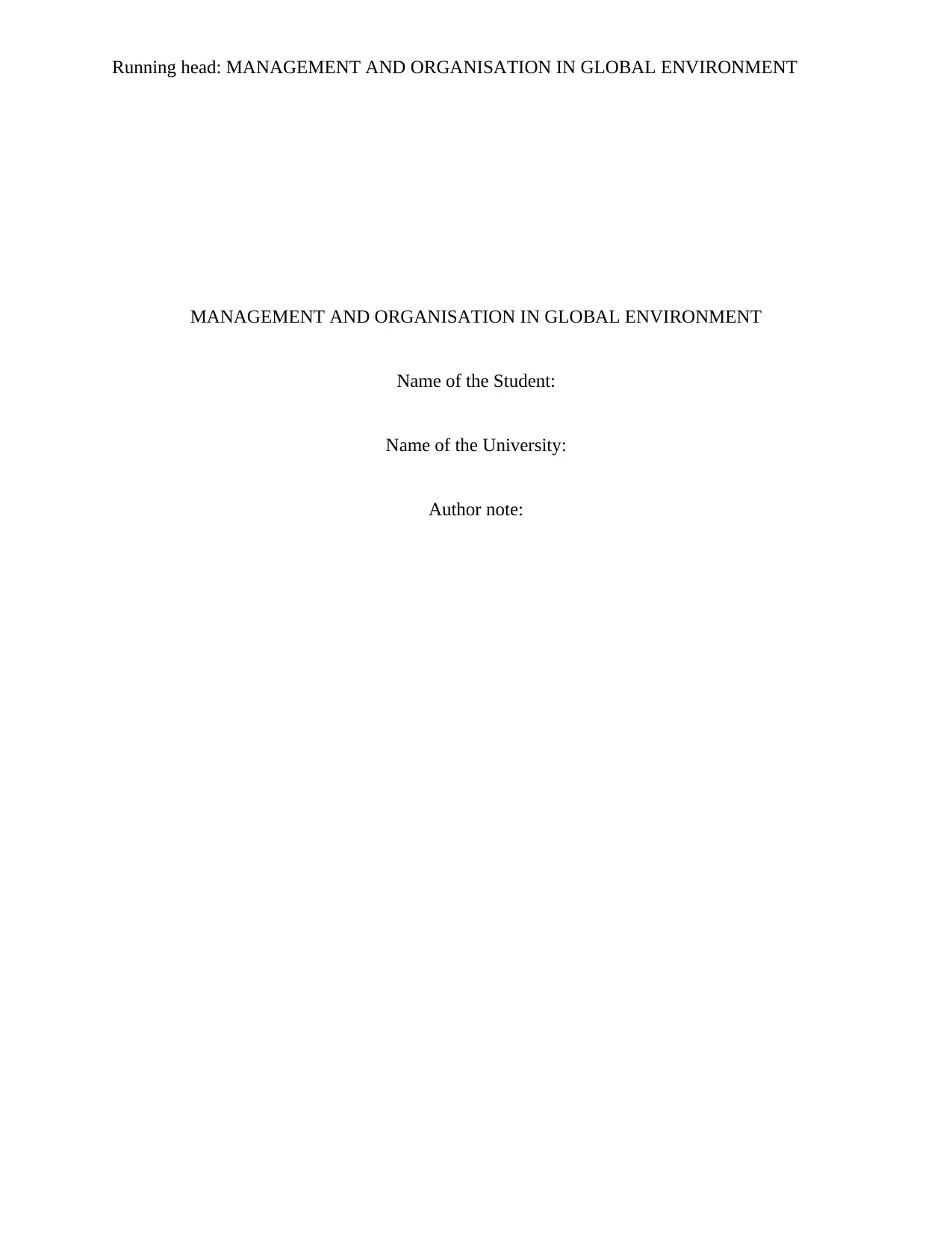
Running head: MANAGEMENT AND ORGANISATION IN GLOBAL ENVIRONMENT
MANAGEMENT AND ORGANISATION IN GLOBAL ENVIRONMENT
Name of the Student:
Name of the University:
Author note:
MANAGEMENT AND ORGANISATION IN GLOBAL ENVIRONMENT
Name of the Student:
Name of the University:
Author note:
Paraphrase This Document
Need a fresh take? Get an instant paraphrase of this document with our AI Paraphraser
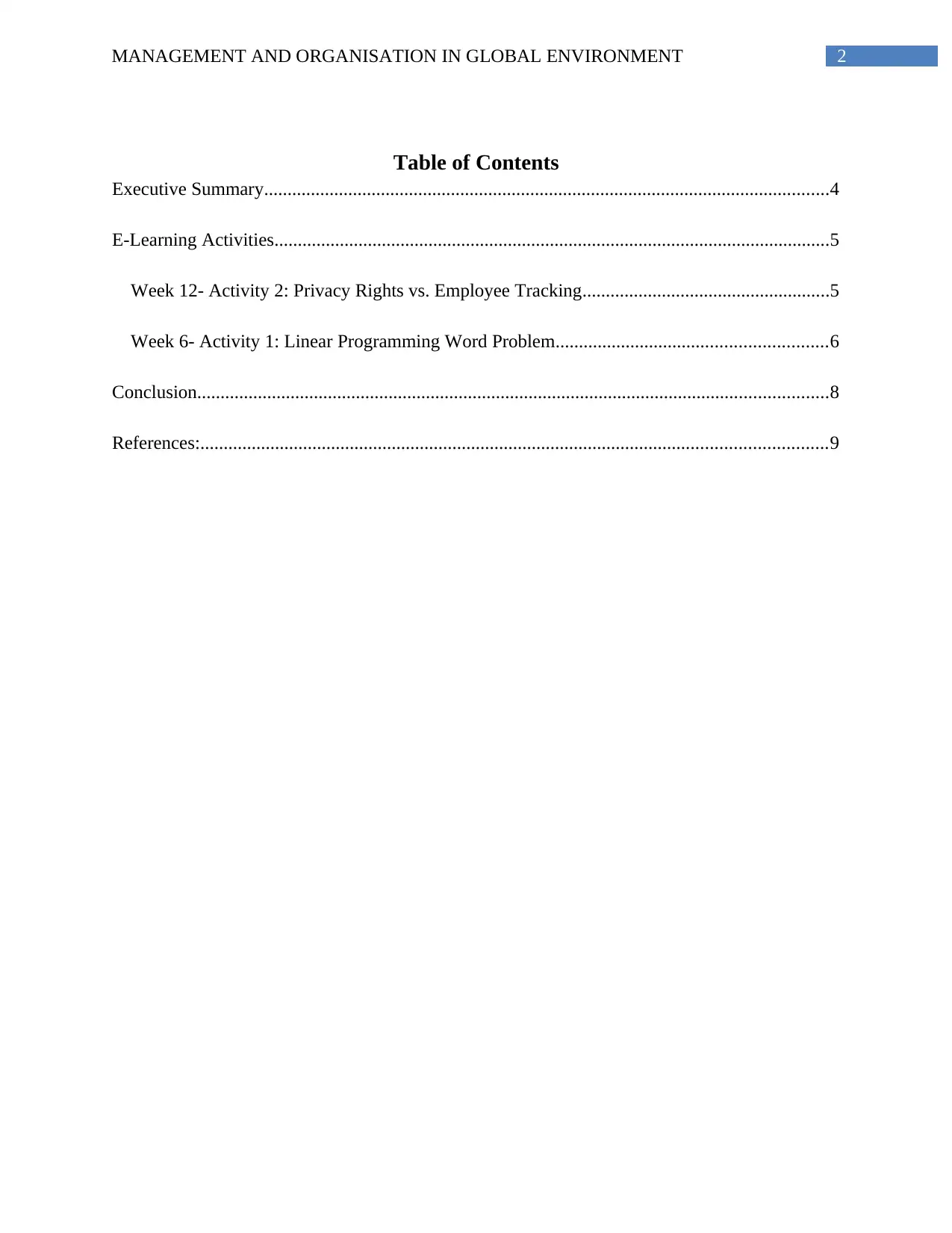
2MANAGEMENT AND ORGANISATION IN GLOBAL ENVIRONMENT
Table of Contents
Executive Summary.........................................................................................................................4
E-Learning Activities.......................................................................................................................5
Week 12- Activity 2: Privacy Rights vs. Employee Tracking.....................................................5
Week 6- Activity 1: Linear Programming Word Problem..........................................................6
Conclusion.......................................................................................................................................8
References:......................................................................................................................................9
Table of Contents
Executive Summary.........................................................................................................................4
E-Learning Activities.......................................................................................................................5
Week 12- Activity 2: Privacy Rights vs. Employee Tracking.....................................................5
Week 6- Activity 1: Linear Programming Word Problem..........................................................6
Conclusion.......................................................................................................................................8
References:......................................................................................................................................9
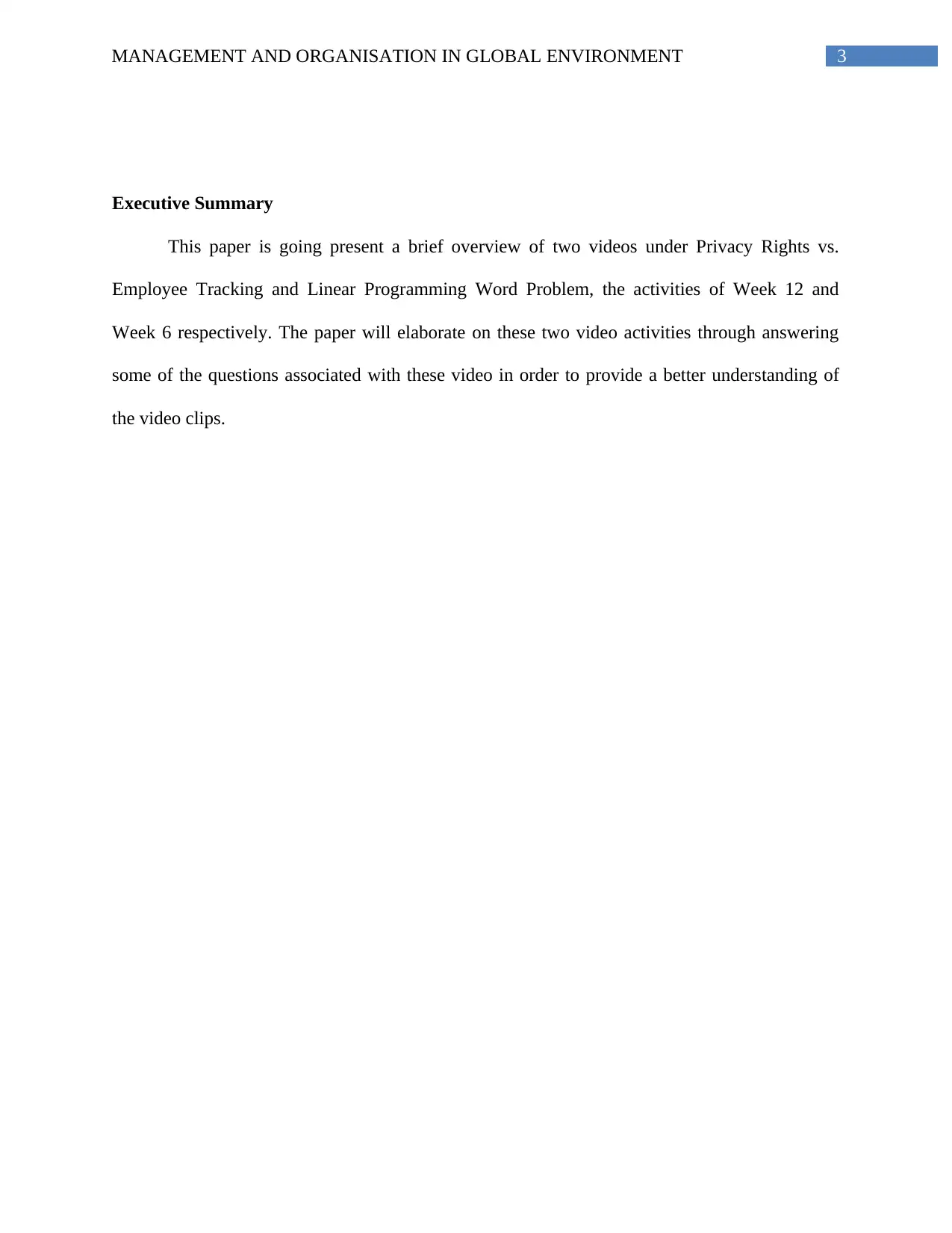
3MANAGEMENT AND ORGANISATION IN GLOBAL ENVIRONMENT
Executive Summary
This paper is going present a brief overview of two videos under Privacy Rights vs.
Employee Tracking and Linear Programming Word Problem, the activities of Week 12 and
Week 6 respectively. The paper will elaborate on these two video activities through answering
some of the questions associated with these video in order to provide a better understanding of
the video clips.
Executive Summary
This paper is going present a brief overview of two videos under Privacy Rights vs.
Employee Tracking and Linear Programming Word Problem, the activities of Week 12 and
Week 6 respectively. The paper will elaborate on these two video activities through answering
some of the questions associated with these video in order to provide a better understanding of
the video clips.
⊘ This is a preview!⊘
Do you want full access?
Subscribe today to unlock all pages.

Trusted by 1+ million students worldwide
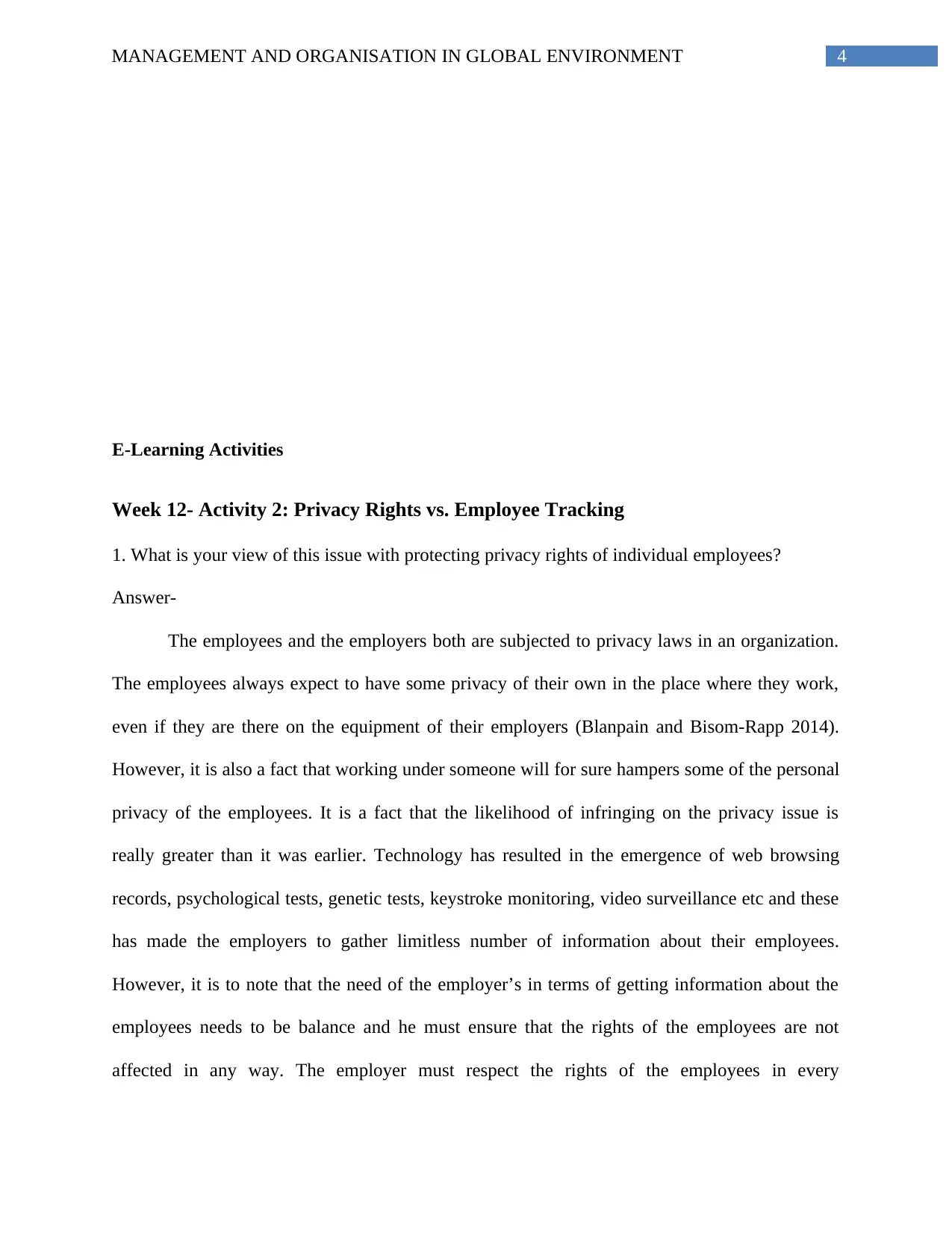
4MANAGEMENT AND ORGANISATION IN GLOBAL ENVIRONMENT
E-Learning Activities
Week 12- Activity 2: Privacy Rights vs. Employee Tracking
1. What is your view of this issue with protecting privacy rights of individual employees?
Answer-
The employees and the employers both are subjected to privacy laws in an organization.
The employees always expect to have some privacy of their own in the place where they work,
even if they are there on the equipment of their employers (Blanpain and Bisom-Rapp 2014).
However, it is also a fact that working under someone will for sure hampers some of the personal
privacy of the employees. It is a fact that the likelihood of infringing on the privacy issue is
really greater than it was earlier. Technology has resulted in the emergence of web browsing
records, psychological tests, genetic tests, keystroke monitoring, video surveillance etc and these
has made the employers to gather limitless number of information about their employees.
However, it is to note that the need of the employer’s in terms of getting information about the
employees needs to be balance and he must ensure that the rights of the employees are not
affected in any way. The employer must respect the rights of the employees in every
E-Learning Activities
Week 12- Activity 2: Privacy Rights vs. Employee Tracking
1. What is your view of this issue with protecting privacy rights of individual employees?
Answer-
The employees and the employers both are subjected to privacy laws in an organization.
The employees always expect to have some privacy of their own in the place where they work,
even if they are there on the equipment of their employers (Blanpain and Bisom-Rapp 2014).
However, it is also a fact that working under someone will for sure hampers some of the personal
privacy of the employees. It is a fact that the likelihood of infringing on the privacy issue is
really greater than it was earlier. Technology has resulted in the emergence of web browsing
records, psychological tests, genetic tests, keystroke monitoring, video surveillance etc and these
has made the employers to gather limitless number of information about their employees.
However, it is to note that the need of the employer’s in terms of getting information about the
employees needs to be balance and he must ensure that the rights of the employees are not
affected in any way. The employer must respect the rights of the employees in every
Paraphrase This Document
Need a fresh take? Get an instant paraphrase of this document with our AI Paraphraser
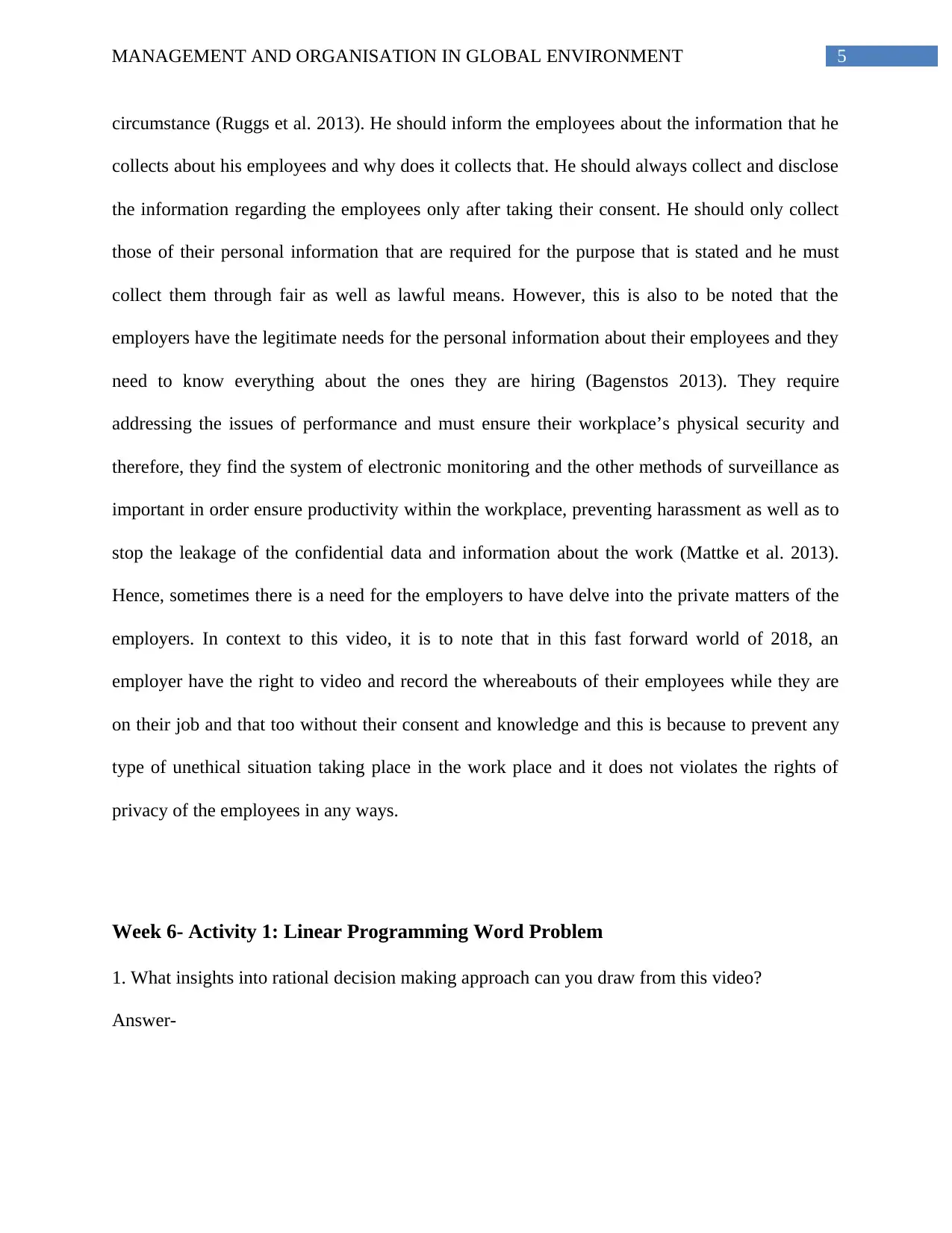
5MANAGEMENT AND ORGANISATION IN GLOBAL ENVIRONMENT
circumstance (Ruggs et al. 2013). He should inform the employees about the information that he
collects about his employees and why does it collects that. He should always collect and disclose
the information regarding the employees only after taking their consent. He should only collect
those of their personal information that are required for the purpose that is stated and he must
collect them through fair as well as lawful means. However, this is also to be noted that the
employers have the legitimate needs for the personal information about their employees and they
need to know everything about the ones they are hiring (Bagenstos 2013). They require
addressing the issues of performance and must ensure their workplace’s physical security and
therefore, they find the system of electronic monitoring and the other methods of surveillance as
important in order ensure productivity within the workplace, preventing harassment as well as to
stop the leakage of the confidential data and information about the work (Mattke et al. 2013).
Hence, sometimes there is a need for the employers to have delve into the private matters of the
employers. In context to this video, it is to note that in this fast forward world of 2018, an
employer have the right to video and record the whereabouts of their employees while they are
on their job and that too without their consent and knowledge and this is because to prevent any
type of unethical situation taking place in the work place and it does not violates the rights of
privacy of the employees in any ways.
Week 6- Activity 1: Linear Programming Word Problem
1. What insights into rational decision making approach can you draw from this video?
Answer-
circumstance (Ruggs et al. 2013). He should inform the employees about the information that he
collects about his employees and why does it collects that. He should always collect and disclose
the information regarding the employees only after taking their consent. He should only collect
those of their personal information that are required for the purpose that is stated and he must
collect them through fair as well as lawful means. However, this is also to be noted that the
employers have the legitimate needs for the personal information about their employees and they
need to know everything about the ones they are hiring (Bagenstos 2013). They require
addressing the issues of performance and must ensure their workplace’s physical security and
therefore, they find the system of electronic monitoring and the other methods of surveillance as
important in order ensure productivity within the workplace, preventing harassment as well as to
stop the leakage of the confidential data and information about the work (Mattke et al. 2013).
Hence, sometimes there is a need for the employers to have delve into the private matters of the
employers. In context to this video, it is to note that in this fast forward world of 2018, an
employer have the right to video and record the whereabouts of their employees while they are
on their job and that too without their consent and knowledge and this is because to prevent any
type of unethical situation taking place in the work place and it does not violates the rights of
privacy of the employees in any ways.
Week 6- Activity 1: Linear Programming Word Problem
1. What insights into rational decision making approach can you draw from this video?
Answer-
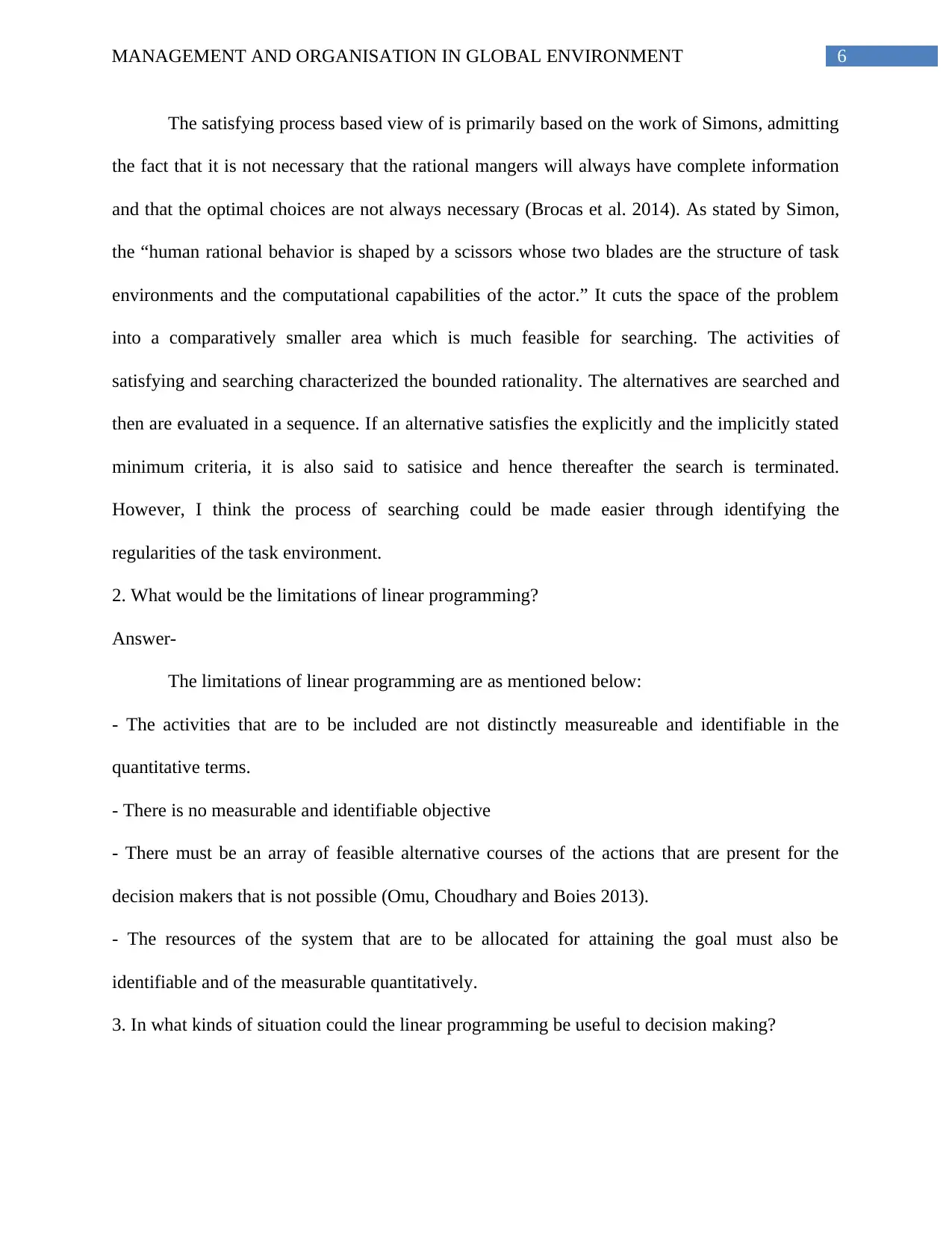
6MANAGEMENT AND ORGANISATION IN GLOBAL ENVIRONMENT
The satisfying process based view of is primarily based on the work of Simons, admitting
the fact that it is not necessary that the rational mangers will always have complete information
and that the optimal choices are not always necessary (Brocas et al. 2014). As stated by Simon,
the “human rational behavior is shaped by a scissors whose two blades are the structure of task
environments and the computational capabilities of the actor.” It cuts the space of the problem
into a comparatively smaller area which is much feasible for searching. The activities of
satisfying and searching characterized the bounded rationality. The alternatives are searched and
then are evaluated in a sequence. If an alternative satisfies the explicitly and the implicitly stated
minimum criteria, it is also said to satisice and hence thereafter the search is terminated.
However, I think the process of searching could be made easier through identifying the
regularities of the task environment.
2. What would be the limitations of linear programming?
Answer-
The limitations of linear programming are as mentioned below:
- The activities that are to be included are not distinctly measureable and identifiable in the
quantitative terms.
- There is no measurable and identifiable objective
- There must be an array of feasible alternative courses of the actions that are present for the
decision makers that is not possible (Omu, Choudhary and Boies 2013).
- The resources of the system that are to be allocated for attaining the goal must also be
identifiable and of the measurable quantitatively.
3. In what kinds of situation could the linear programming be useful to decision making?
The satisfying process based view of is primarily based on the work of Simons, admitting
the fact that it is not necessary that the rational mangers will always have complete information
and that the optimal choices are not always necessary (Brocas et al. 2014). As stated by Simon,
the “human rational behavior is shaped by a scissors whose two blades are the structure of task
environments and the computational capabilities of the actor.” It cuts the space of the problem
into a comparatively smaller area which is much feasible for searching. The activities of
satisfying and searching characterized the bounded rationality. The alternatives are searched and
then are evaluated in a sequence. If an alternative satisfies the explicitly and the implicitly stated
minimum criteria, it is also said to satisice and hence thereafter the search is terminated.
However, I think the process of searching could be made easier through identifying the
regularities of the task environment.
2. What would be the limitations of linear programming?
Answer-
The limitations of linear programming are as mentioned below:
- The activities that are to be included are not distinctly measureable and identifiable in the
quantitative terms.
- There is no measurable and identifiable objective
- There must be an array of feasible alternative courses of the actions that are present for the
decision makers that is not possible (Omu, Choudhary and Boies 2013).
- The resources of the system that are to be allocated for attaining the goal must also be
identifiable and of the measurable quantitatively.
3. In what kinds of situation could the linear programming be useful to decision making?
⊘ This is a preview!⊘
Do you want full access?
Subscribe today to unlock all pages.

Trusted by 1+ million students worldwide
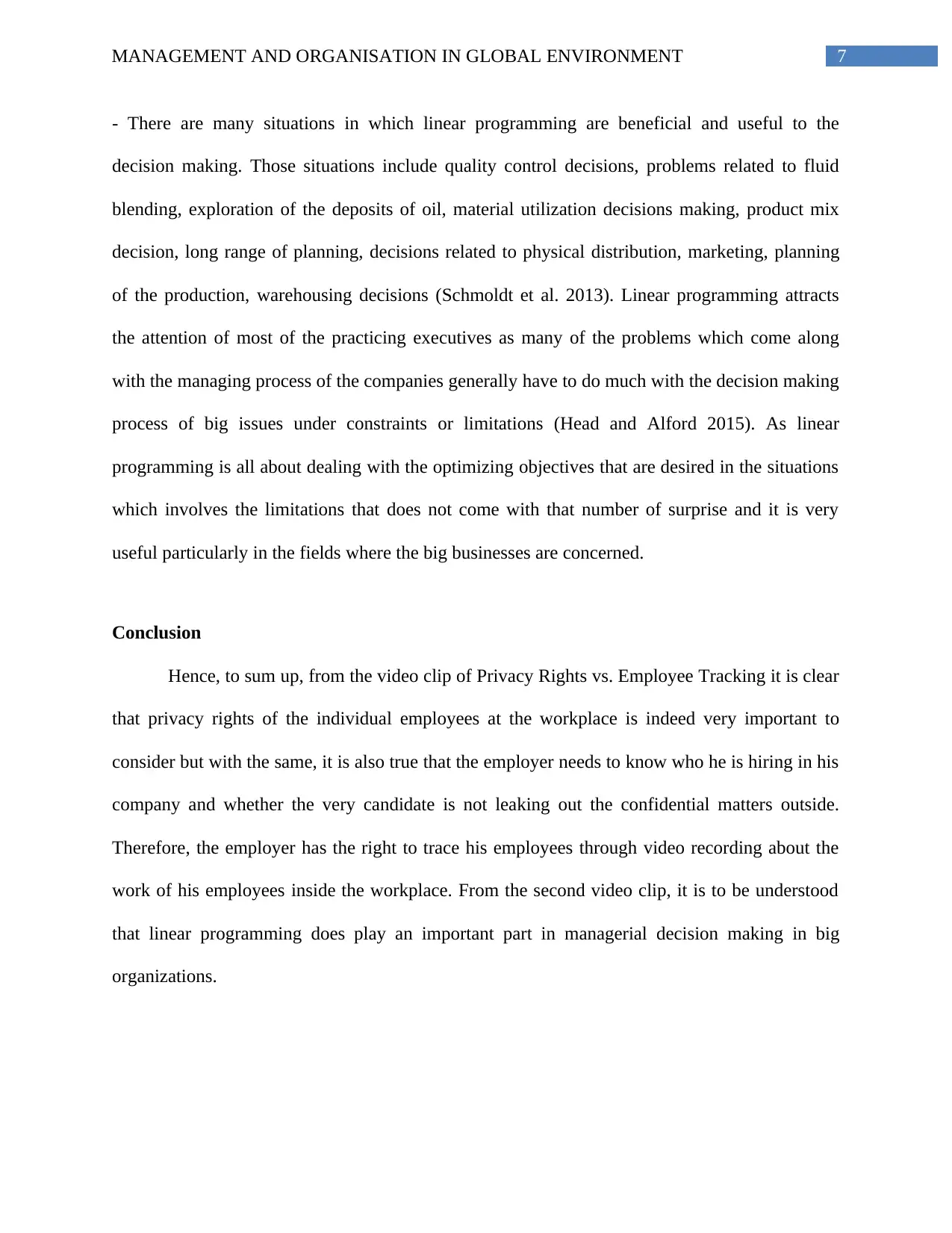
7MANAGEMENT AND ORGANISATION IN GLOBAL ENVIRONMENT
- There are many situations in which linear programming are beneficial and useful to the
decision making. Those situations include quality control decisions, problems related to fluid
blending, exploration of the deposits of oil, material utilization decisions making, product mix
decision, long range of planning, decisions related to physical distribution, marketing, planning
of the production, warehousing decisions (Schmoldt et al. 2013). Linear programming attracts
the attention of most of the practicing executives as many of the problems which come along
with the managing process of the companies generally have to do much with the decision making
process of big issues under constraints or limitations (Head and Alford 2015). As linear
programming is all about dealing with the optimizing objectives that are desired in the situations
which involves the limitations that does not come with that number of surprise and it is very
useful particularly in the fields where the big businesses are concerned.
Conclusion
Hence, to sum up, from the video clip of Privacy Rights vs. Employee Tracking it is clear
that privacy rights of the individual employees at the workplace is indeed very important to
consider but with the same, it is also true that the employer needs to know who he is hiring in his
company and whether the very candidate is not leaking out the confidential matters outside.
Therefore, the employer has the right to trace his employees through video recording about the
work of his employees inside the workplace. From the second video clip, it is to be understood
that linear programming does play an important part in managerial decision making in big
organizations.
- There are many situations in which linear programming are beneficial and useful to the
decision making. Those situations include quality control decisions, problems related to fluid
blending, exploration of the deposits of oil, material utilization decisions making, product mix
decision, long range of planning, decisions related to physical distribution, marketing, planning
of the production, warehousing decisions (Schmoldt et al. 2013). Linear programming attracts
the attention of most of the practicing executives as many of the problems which come along
with the managing process of the companies generally have to do much with the decision making
process of big issues under constraints or limitations (Head and Alford 2015). As linear
programming is all about dealing with the optimizing objectives that are desired in the situations
which involves the limitations that does not come with that number of surprise and it is very
useful particularly in the fields where the big businesses are concerned.
Conclusion
Hence, to sum up, from the video clip of Privacy Rights vs. Employee Tracking it is clear
that privacy rights of the individual employees at the workplace is indeed very important to
consider but with the same, it is also true that the employer needs to know who he is hiring in his
company and whether the very candidate is not leaking out the confidential matters outside.
Therefore, the employer has the right to trace his employees through video recording about the
work of his employees inside the workplace. From the second video clip, it is to be understood
that linear programming does play an important part in managerial decision making in big
organizations.
Paraphrase This Document
Need a fresh take? Get an instant paraphrase of this document with our AI Paraphraser
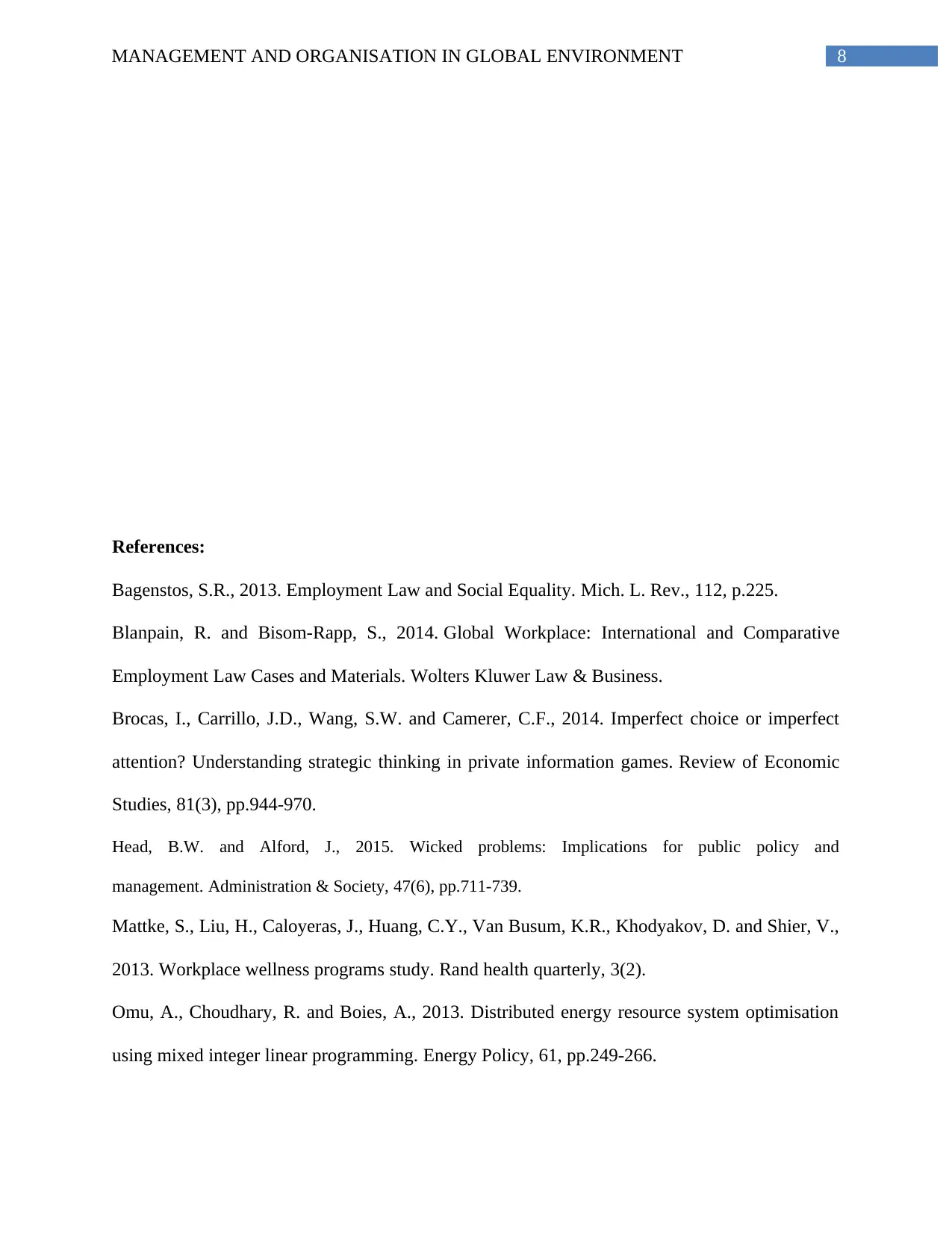
8MANAGEMENT AND ORGANISATION IN GLOBAL ENVIRONMENT
References:
Bagenstos, S.R., 2013. Employment Law and Social Equality. Mich. L. Rev., 112, p.225.
Blanpain, R. and Bisom-Rapp, S., 2014. Global Workplace: International and Comparative
Employment Law Cases and Materials. Wolters Kluwer Law & Business.
Brocas, I., Carrillo, J.D., Wang, S.W. and Camerer, C.F., 2014. Imperfect choice or imperfect
attention? Understanding strategic thinking in private information games. Review of Economic
Studies, 81(3), pp.944-970.
Head, B.W. and Alford, J., 2015. Wicked problems: Implications for public policy and
management. Administration & Society, 47(6), pp.711-739.
Mattke, S., Liu, H., Caloyeras, J., Huang, C.Y., Van Busum, K.R., Khodyakov, D. and Shier, V.,
2013. Workplace wellness programs study. Rand health quarterly, 3(2).
Omu, A., Choudhary, R. and Boies, A., 2013. Distributed energy resource system optimisation
using mixed integer linear programming. Energy Policy, 61, pp.249-266.
References:
Bagenstos, S.R., 2013. Employment Law and Social Equality. Mich. L. Rev., 112, p.225.
Blanpain, R. and Bisom-Rapp, S., 2014. Global Workplace: International and Comparative
Employment Law Cases and Materials. Wolters Kluwer Law & Business.
Brocas, I., Carrillo, J.D., Wang, S.W. and Camerer, C.F., 2014. Imperfect choice or imperfect
attention? Understanding strategic thinking in private information games. Review of Economic
Studies, 81(3), pp.944-970.
Head, B.W. and Alford, J., 2015. Wicked problems: Implications for public policy and
management. Administration & Society, 47(6), pp.711-739.
Mattke, S., Liu, H., Caloyeras, J., Huang, C.Y., Van Busum, K.R., Khodyakov, D. and Shier, V.,
2013. Workplace wellness programs study. Rand health quarterly, 3(2).
Omu, A., Choudhary, R. and Boies, A., 2013. Distributed energy resource system optimisation
using mixed integer linear programming. Energy Policy, 61, pp.249-266.
1 out of 8
Related Documents
Your All-in-One AI-Powered Toolkit for Academic Success.
+13062052269
info@desklib.com
Available 24*7 on WhatsApp / Email
![[object Object]](/_next/static/media/star-bottom.7253800d.svg)
Unlock your academic potential
Copyright © 2020–2025 A2Z Services. All Rights Reserved. Developed and managed by ZUCOL.





